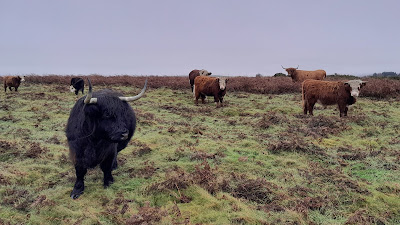Wednesday 4th Deecember 2024, Rhos Fiddle SWT Reserve
Imagine that you were driving along a quiet country lane through the very sparsely populated upland grasslands of south-west Shropshire, on a cold, misty day, in December, and you happened to notice a group of people in a field waving nets around, carrying trays, sticks and leaf blowers.
What would you think?
…?
It is your imagination at play here, I am not going to suggest what you might think, but I know what I would!
Rhos Fiddle is a large upland grassland/heathland site managed by the Shropshire Wildlife Trust. During our visit earlier this year I noticed large amounts of Polytrichum moss on the site, which attracted me to the idea of a winter visit to see if we could find Snow fleas.
Rather than keep you in suspense, we did not find any.
As it turned out, we found very little else on the day. But we had some fun trying.
However, our meagre findings were crowned by the first record in the county of Phthitia longisetosa, a small fly.
How do you pronounce that name?
We also came across this red hairy mite.
 |
| Photograph: Nigel Jones |
I think I have got ahead of myself.
Back to the start.
On arrival, as we left the pleasantly warm transport, we were hit by the bitingly cold, damp atmosphere.
We scrambled for appropriate attire to try and retain what body heat we had for as long as possible. I even heard the phrase “wearing electric socks”.
Are discussions about electric socks (and other items of clothing) going to displace electric bikes in our conversations?
When fully dressed I counted my layers – seven – plus double gloves and two hats.
Would that keep me warm?
Time would tell.
We negotiated the stile and waddled onto the site, aiming for the area where we had found the Polytrichum previously.
Soon the sound of a suction sampler was heard as a rough patch of vegetation was too tempting to resist.
This first sample revealed two micro-ladybirds:
Coccidula rufa;
 |
| Photograph: David Williams |
And Nephus redtenbacheri.
 |
| Photograph: David Williams |
Despite our best efforts body temperatures were dropping, and it became necessary to huddle up.
I noticed a gorse with a couple of flowers braving the elements.
Someone observed a moth perched on some heather. It was not going anywhere in the conditions and surrendered willingly to the warmth of a glass tube in the hand, where it was photographed.
 |
| Photograph: John Martin |
This is Acleris hyemana, a strikingly marked moth providing a flash of colour at a drab time of year.
The site is grazed, as part of its management, by sheep and cattle.
After a while our paths crossed.
 |
| Photograph: John Martin |
I am not sure who was more curious, the cattle or us.
Judging from the photographs I have received from the group taken during this visit it may well have been us, as a third were of the cattle!
 |
| Photograph: David Williams |
But maybe some of the cattle were equally curious. As the photographer remarked “The friendly locals were captured with my phone as every time I put my bag down to extract my camera from it, they rushed me!”.
Do they associate camera bags with food?
Here is one of the locals.
 |
| Photograph: David Williams |
And another.
 |
| Photograph: David Williams |
Tearing ourselves away from the cattle and concentrating on matters entomological we found the “bendy” beetle, Encephalus complicans.
.jpg) |
| Photograph: David Williams |
Here is the same beetle with its abdomen folded over its back.
.jpg) |
| Photograph: David Williams |
I am not aware that it has a common name, so time to give it one…
How about “the Contortionist”?
We’ll see if it catches on.
It was lunchtime.
A strong breeze had sprung up and it was suggested we shelter from it behind some gorse.
The gorse provided some relief, perhaps, if you were one of the “have-nots” (i.e. do not carry a seat) who sat on the ground, but for the “haves” there was little shelter.
Lunch over we carried on for another hour or so before the chill finally overcame our clothing and we retreated back to the cars.
On the way we spotted a picture-winged fly, Tephritis vespertina.
 |
| Photograph: John Martin |
But the day was not over as it was known that Tree sparrows and Bramblings had been seen nearby. A splinter group wandered off in search of these.
They were successful in their quest, finding both.
Tree sparrow.
 |
| Photograph: John Martin |
Brambling.
 |
| Photograph: John Martin |
And a flower, Red lungwort, for good measure.
 |
| Photograph: John Martin |
Now, we made our way to our homes.
My thanks to the Shropshire Wildlife Trust for granting us permission to do what we enjoy doing, and to the photographers for their excellent images and allowing me to use them in this report.


.JPG)










.JPG)




.JPG)













.JPG)







